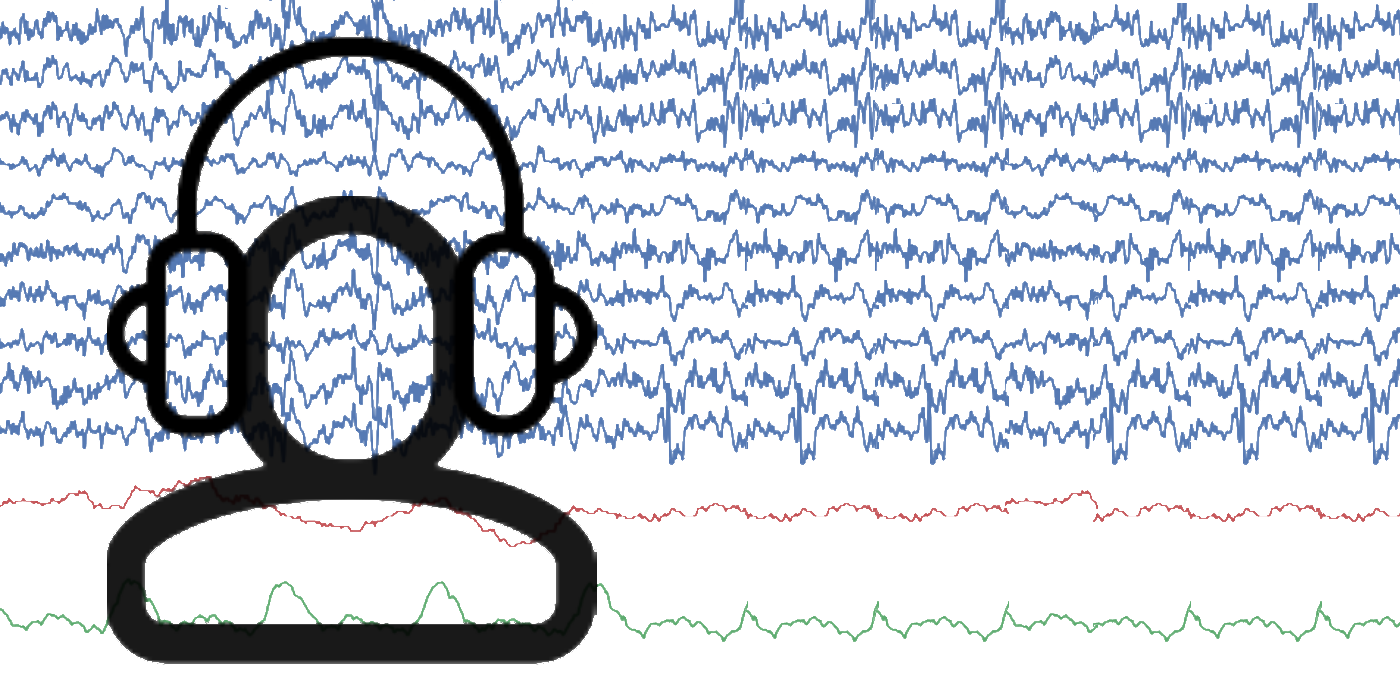All four predictive tasks using SVM
In this notebook, we explain to download the dataset and getting started with all the predictive tasks using Support Vector Machine. We will be extracting spectral features, specifically 6 rhythmic features - total power in 6 frequency bands, namely, Delta (0.5-4 Hz), Theta (4-8 Hz), Alpha (8-14 Hz), Beta (14-30 Hz), Low Gamma (30-47 Hz), and High Gamma (47-64 Hz). For preprocessing, we filter EEG first with 0.5 Hz highpass and then remove Artifact with ICA based approach.

Table of Contents
Import libraries
import numpy as np
import pandas as pd
import matplotlib.pyplot as plt
#!pip install phyaat # if not installed yet
import phyaat
print('Version :' ,phyaat.__version__)
import phyaat as ph
PhyAAt Processing lib Loaded...
Version : 0.0.2
Download Data
# Download dataset of one subject only (subject=1)
# To download data of all the subjects use subject =-1 or for specify for one e.g.subject=10
dirPath = ph.download_data(baseDir='../PhyAAt_Data', subject=1,verbose=0,overwrite=False)
100%[|][##################################################] S1
Locate the subject’s file
baseDir='../PhyAAt_Data' # or dirPath return path from above
#returns a dictionary containing file names of all the subjects available in baseDir
SubID = ph.ReadFilesPath(baseDir)
#check files of subject=1
SubID[1]
Total Subjects : 1
{'sigFile': '../PhyAAt_Data/phyaat_dataset/Signals/S1/S1_Signals.csv',
'txtFile': '../PhyAAt_Data/phyaat_dataset/Signals/S1/S1_Textscore.csv'}
Loading data and preprocessing
Create Subj (obj) with data of Subject=1
# Create a Subj holding dataset of subject=1
Subj = ph.Subject(SubID[1])
Filtering - removing DC
#filtering with highpass filter of cutoff frequency 0.5Hz
Subj.filter_EEG(band =[0.5],btype='highpass',order=5)
Artifact removal using ICA [ ~6mins]
#Remving Artifact using ICA, setting window size to 1280 (10sec), which is larg, but takes less time
Subj.correct(method='ICA',verbose=1,winsize=128*10)
ICA Artifact Removal : extended-infomax
100%|####################################################################################################|
Feature Extraction - Rhythmic Features [~2min]
# setting task=-1, does extract the features from all the segmensts for all the four tasks and
# returns y_train as (n,4), one coulum for each task. Next time extracting Xy for any particular
# task won't extract the features agains, unless you force it by setting 'redo'=True.
X_train,y_train,X_test, y_test = Subj.getXy_eeg(task=-1)
print('DataShape: ',X_train.shape,y_train.shape,X_test.shape, y_test.shape)
100%|##################################################|100\100|Sg - 0
Done..
100%|##################################################|100\100|Sg - 1
Done..
100%|##################################################|100\100|Sg - 2
Done..
100%|##################################################|43\43|Sg - 0
Done..
100%|##################################################|43\43|Sg - 1
Done..
100%|##################################################|43\43|Sg - 2
Done..
DataShape: (290, 84) (290, 4) (120, 84) (120, 4)
Predictive Modeling with SVM
from sklearn import svm
T4 Task: LWR classification
X_train,y_train, X_test,y_test = Subj.getXy_eeg(task=4)
print('DataShape: ',X_train.shape,y_train.shape,X_test.shape, y_test.shape)
print('\nClass labels :',np.unique(y_train))
DataShape: (290, 84) (290,) (120, 84) (120,)
Class labels : [0 1 2]
# Normalization - SVM works well with normalized features
means = X_train.mean(0)
std = X_train.std(0)
X_train = (X_train-means)/std
X_test = (X_test-means)/std
# Training
clf = svm.SVC(kernel='rbf', C=1,gamma='auto')
clf.fit(X_train,y_train)
# Predition
ytp = clf.predict(X_train)
ysp = clf.predict(X_test)
# Evaluation
T4_trac = np.mean(y_train==ytp)
T4_tsac = np.mean(y_test==ysp)
print('Training Accuracy:',T4_trac)
print('Testing Accuracy:',T4_tsac)
Training Accuracy: 0.9551724137931035
Testing Accuracy: 0.875
T3 Task: Semanticity classification
X_train,y_train, X_test,y_test = Subj.getXy_eeg(task=3)
print('DataShape: ',X_train.shape,y_train.shape,X_test.shape, y_test.shape)
print('\nClass labels :',np.unique(y_train))
DataShape: (100, 84) (100,) (43, 84) (43,)
Class labels : [0 1]
# Normalization - SVM works well with normalized features
means = X_train.mean(0)
std = X_train.std(0)
X_train = (X_train-means)/std
X_test = (X_test-means)/std
# Training
clf = svm.SVC(kernel='rbf', C=1,gamma='auto')
clf.fit(X_train,y_train)
# Predition
ytp = clf.predict(X_train)
ysp = clf.predict(X_test)
# Evaluation
T3_trac = np.mean(y_train==ytp)
T3_tsac = np.mean(y_test==ysp)
print('Training Accuracy:',T3_trac)
print('Testing Accuracy:',T3_tsac)
Training Accuracy: 0.86
Testing Accuracy: 0.6046511627906976
T2 Task: Noise level prediction : Regression
X_train,y_train, X_test,y_test = Subj.getXy_eeg(task=2)
print('DataShape: ',X_train.shape,y_train.shape,X_test.shape, y_test.shape)
print('\nNoise levels :',np.unique(y_train))
#change 1000 dB to 10 dB
y_train[y_train==1000]=10
y_test[y_test==1000]=10
print('New Noise levels :',np.unique(y_train))
DataShape: (100, 84) (100,) (43, 84) (43,)
Noise levels : [ -6 -3 0 3 6 1000]
New Noise levels : [-6 -3 0 3 6 10]
# Normalization - SVM works well with normalized features
means = X_train.mean(0)
std = X_train.std(0)
X_train = (X_train-means)/std
X_test = (X_test-means)/std
# Training
clf = svm.SVR(kernel='rbf', C=1,gamma='auto')
clf.fit(X_train,y_train)
# Predition
ytp = clf.predict(X_train)
ysp = clf.predict(X_test)
# Evaluation
T2_tre = np.mean(np.abs(y_train-ytp))
T2_tse = np.mean(np.abs(y_test-ysp))
print('Training MAE:',T2_tre)
print('Testing MAE:',T2_tse)
Training MAE: 3.9959210189119596
Testing MAE: 4.692983467091375
T1 Task: Attention Level prediction: Regression
X_train,y_train, X_test,y_test = Subj.getXy_eeg(task=1)
print('DataShape: ',X_train.shape,y_train.shape,X_test.shape, y_test.shape)
print('\nAttention levels:\n',np.unique(y_train))
# Round off around 10
y_train = 10*(y_train//10)
y_test = 10*(y_test//10)
print('\nNew Attention levels:\n',np.unique(y_train))
DataShape: (100, 84) (100,) (43, 84) (43,)
Attention levels:
[ 0 7 12 14 15 18 20 22 25 28 33 37 38 42 44 45 46 50
54 60 62 66 71 72 75 76 80 83 85 87 88 100]
New Attention levels:
[ 0 10 20 30 40 50 60 70 80 100]
# Normalization - SVM works well with normalized features
means = X_train.mean(0)
std = X_train.std(0)
X_train = (X_train-means)/std
X_test = (X_test-means)/std
# Training
clf = svm.SVR(kernel='rbf', C=1,gamma='auto')
clf.fit(X_train,y_train)
# Predition
ytp = clf.predict(X_train)
ysp = clf.predict(X_test)
# Evaluation
T1_tre = np.mean(np.abs(y_train-ytp))
T1_tse = np.mean(np.abs(y_test-ysp))
print('Training MAE:',T1_tre)
print('Testing MAE:',T1_tse)
Training MAE: 30.318536004889328
Testing MAE: 32.7156301374038
All results
fig = plt.figure(figsize=(13,3))
plt.subplot(141)
plt.bar(1, [T1_tre])
plt.bar(2, [T1_tse])
plt.xlim([0,3])
plt.xticks([])
plt.xlabel('T1: Attention Level',fontsize=13)
plt.ylabel('MAE')
plt.subplot(142)
plt.bar(1, [T2_tre])
plt.bar(2, [T2_tse])
plt.xticks([])
plt.xlabel('T2: Noise Level',fontsize=13)
plt.ylabel('MAE')
plt.xlim([0,3])
plt.subplot(143)
plt.bar(1, [T3_trac])
plt.bar(2, [T3_tsac])
plt.xticks([])
plt.xlabel('T3: Semanticity',fontsize=13)
plt.ylabel('Accuracy')
plt.xlim([0,3])
plt.subplot(144)
plt.bar(1, [T4_trac],label='Training')
plt.bar(2, [T4_tsac],label='Testing')
plt.xlim([0,3])
plt.xticks([])
plt.xlabel('T4: LWR',fontsize=13)
plt.ylabel('Accuracy')
plt.legend(bbox_to_anchor=(1,1))
plt.subplots_adjust(wspace=0.5)
fig.suptitle("Predictive Tasks with SVM", fontsize="x-large")
plt.show()









